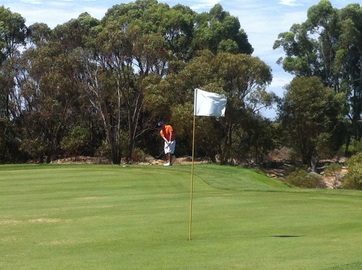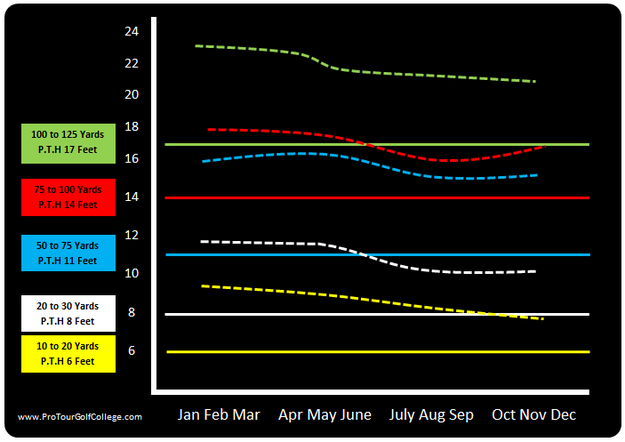 When you play in a golf tournament, to assess how you performed in that event you compare your results to those golfers who finished ahead of you in the field. This is a normal and natural human process that helps you to determine where your game is situated at any particular time. Amateur golfers will customarily compare their golf swings to successful tour professionals; and they will compare their golf scores to other golfers they’re competing against; and they even compare their fashion choice with others in their quest to improve their position or status as a competitive golfer. In last week’s article I discussed the importance of establishing key performance indicators to guide your practice direction and ultimately your performances on the golf course. This week I’ll be talking about how to introduce competitive benchmarking into your development program.  Competitive Benchmarking is a method where you compare your current golf practice processes and golf course performances against the most successful golfers. For example you can compare the way you practice putting results or some other golf skill with professional golfers practicing the same skills, as well as comparing your scores when practicing and performing with them. You can benchmark virtually any skill against the best in the game. So let’s say that you are a good amateur golfer now and you want to be a top level amateur golfer or even a professional golfer in the future, you can look at the performances of the best amateurs and professional performances today and then determine what you need to do to take your game from its current position to that of the very best golfers. Why is this important? Competitive benchmarking challenges elite golfers to examine and also understand where their current golf standard is and gives them a higher standard to continually aim and drive their game at. At Pro Tour Golf College our competitive benchmarks are set against the best golfers on the PGA Tour and European Tour. The reason for this is quite simply that we have access to lots of data that they collect on their players and this helps us to understand just how good these professional tour golfers are. And since they are the best golfers on the planet, it’s not a bad place to start when you think about it.  David showing approach wedge P.T.H of top ranked PGA Tour golfers Many golfers will compare their handicap with another golfer but at Pro Tour Golf College we never compare one golf handicap against another as they’re not a true reflection of an amateur golfers playing standard. We compare golf score averages in tournaments and key golf course statistics such as strokes gained in putting and proximity to the hole metrics. The shot-link data from the US PGA Tour is especially helpful-particularly the data from 100 yards and in as it makes it easier for us to establish accurate and realistic benchmarks for the male and female golfers in our program since virtually every one of them wants to become a successful professional golfer. We believe that all elite golfers can build world class short-games from 100 yards and in and also develop a consistent pro level tee-green performances and the data from the best on the PGA Tour just helps you to stay on track with your performance objectives.  The first place to start is to determine your performance standards for the different shots you are faced with. For instance if you were hitting a chip/pitch or flop shot from within 20 yards of the hole, what would you expect your proximity to the hole to be on average? I bet that you would probably expect your shot to go pretty close to the hole most of the time, but on the PGA Tour the best golfer from 10-20 yards and in (2012) was Justin Rose and from 65 competitive rounds of golf and 138 attempts his proximity to the hole was 5 foot 3 inches or about 1 metre and 60 centimetres. I know that you’re probably thinking that this doesn't seem very close to the hole from just 10-20 yards away from the pin but when you consider all the different situations he was playing his ball from it is an outstanding performance. So this statistic we call ‘Green-Side Skills’ (not including bunker shots). This is a short chip, pitch or flop shot 10 to 20 yards from the hole and even though the distance to the hole is quite short, your ability to get the ball close often really determines to a great extent how many par (or bogey) saves you can make when you miss a green in regulation. So rather than just practicing this green-side shot when close to the hole, (or any shot) it will be more helpful for you establish a performance benchmark first to improve your green-side performances. The table above shows how we do it at Pro Tour Golf College. You can see that we use PGA Tour statistics (10th ranked or tied) to benchmark our players against. In the example above we are benchmarking proximity to the hole metrics from 125 yards and in and also strokes gained metrics for 3 feet to 18 feet in putting (see below). Because we track, test and measure all the distances of shots played on the practice ground and golf course of our students at Pro Tour Golf College we have a very good idea of where they are placed against the best golfers in the game. With a steady stream of results generated we can adjust, and implement specific strategies aimed at moving their performances closer to those of the golfers we benchmark against. This is the great thing about competitive benchmarking in that it allows you to develop highly specific practice plans that can drive on performance improvements in any skill deficient area of your game.
So if you're looking for a great strategy for lowering your golf scores and moving closer to the performances of the top golfers then give competitive benchmarking a try. It might be the best decision you ever make. Lawrie Montague and David Milne - Pro Tour Golf College Your Success on Tour is Our Business
Jossa
26/2/2013 05:54:49 am
Interesting aproache! 26/2/2013 06:27:32 am
Thanks for sharing your comments and we hope you enjoyed the article.
I enjoy the blog posts, the focus of attention to details and measurement as its also responds to how I think about elite level performances. 27/2/2013 08:38:40 pm
Thanks so much for your comments Robert and I'm pleased that you enjoy our blog posts. I'm also happy that our blogs provide you with some ideas to help your golfers. We always appreciate the feedback and wish you the best with your coaching.
Robert
28/2/2013 05:37:36 pm
If you consider hiring, 1/3/2013 05:40:10 am
Thanks again for sharing your comments Robert. It is nice to know that there are coaches like you who look beyond the golf swing for the answers to making elite golfers better faster. We'll let you know when we are looking for coaches for our programs as we expand our brand further. Regards Lawrie Comments are closed.
|
Archives
June 2019
|
Proudly Supported By
Copyright © 2011 - 2018 Pro Tour Golf College
Website Managed By Golf Performance Media
All Rights Reserved
Website Managed By Golf Performance Media
All Rights Reserved



 RSS Feed
RSS Feed



